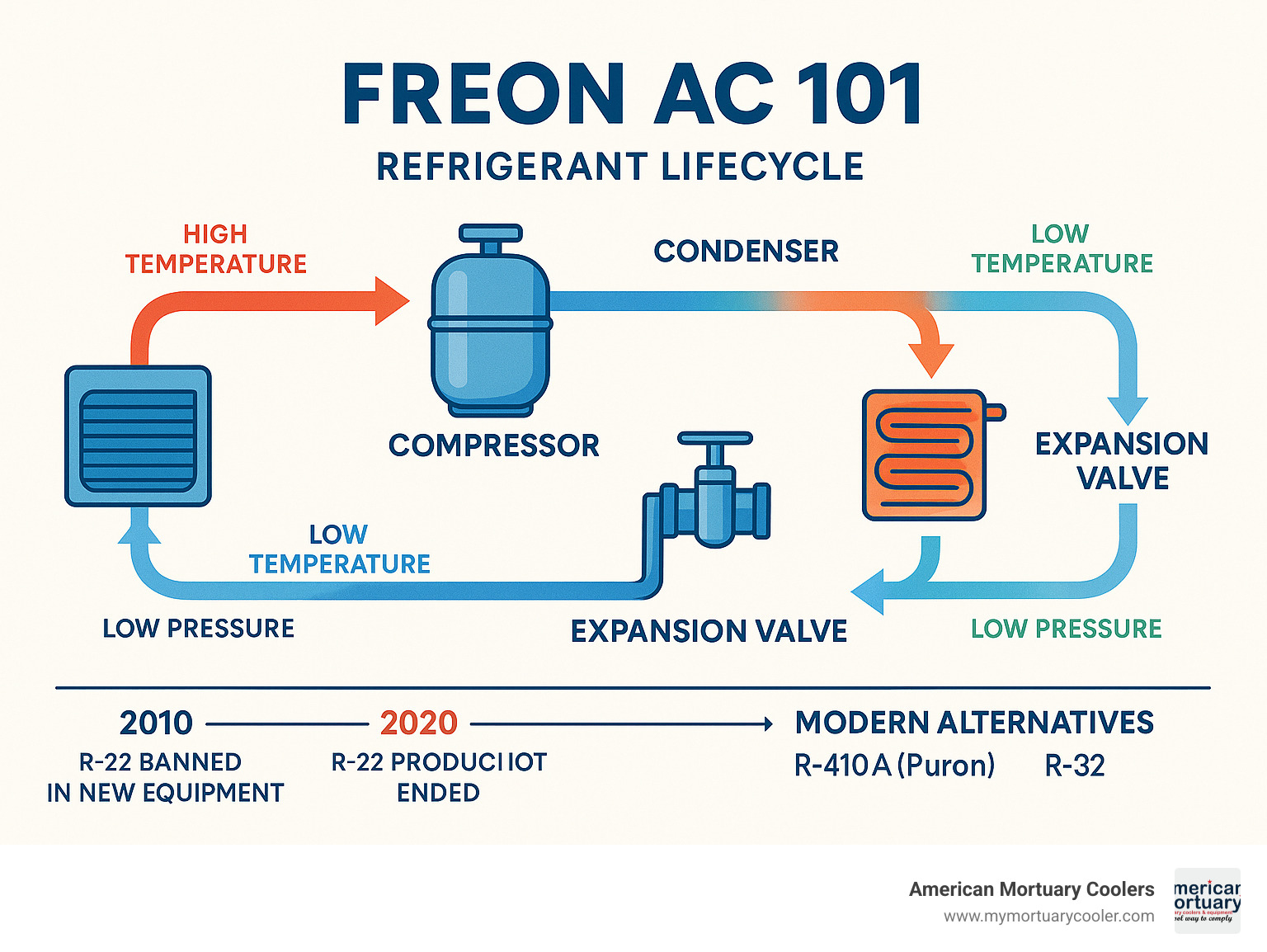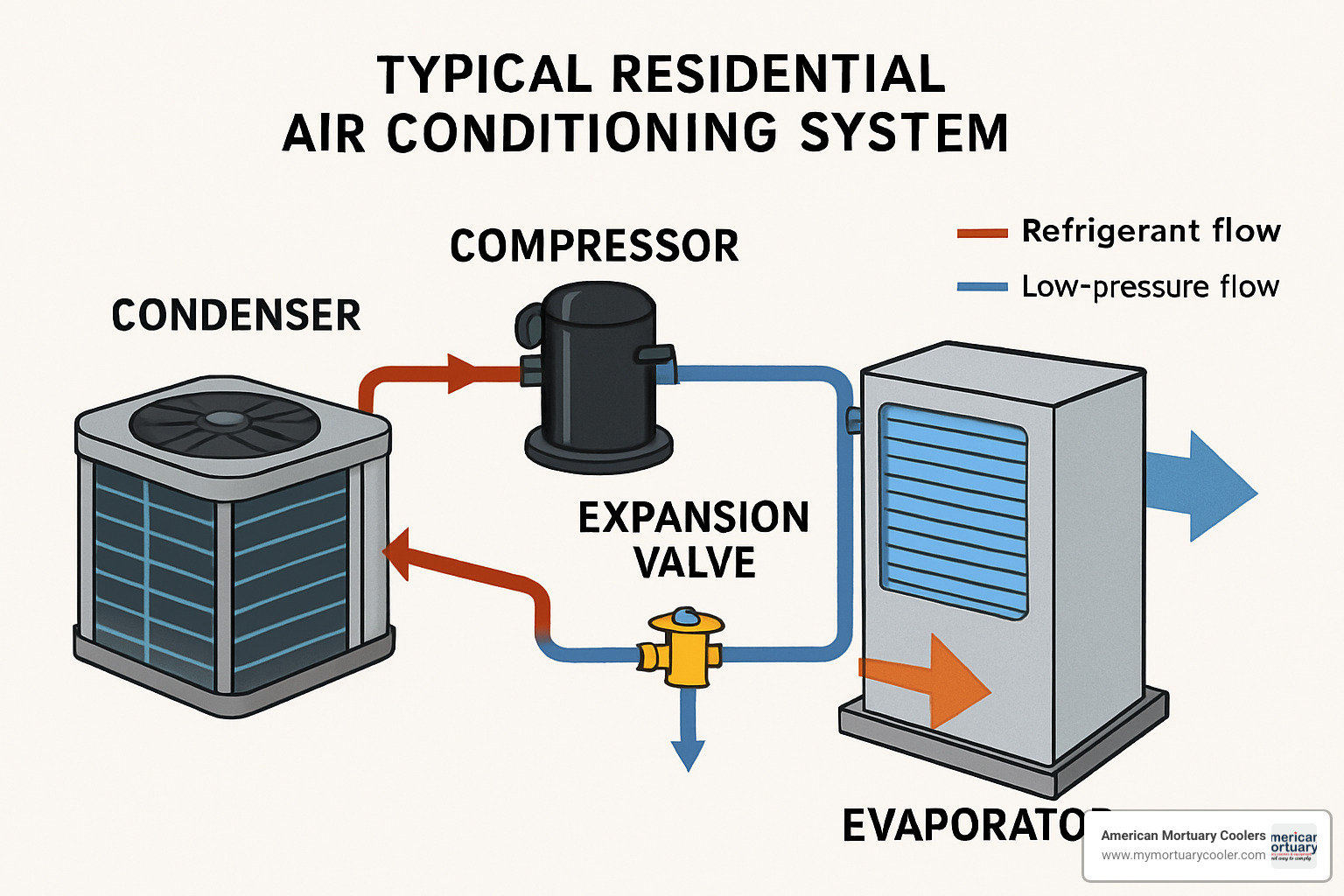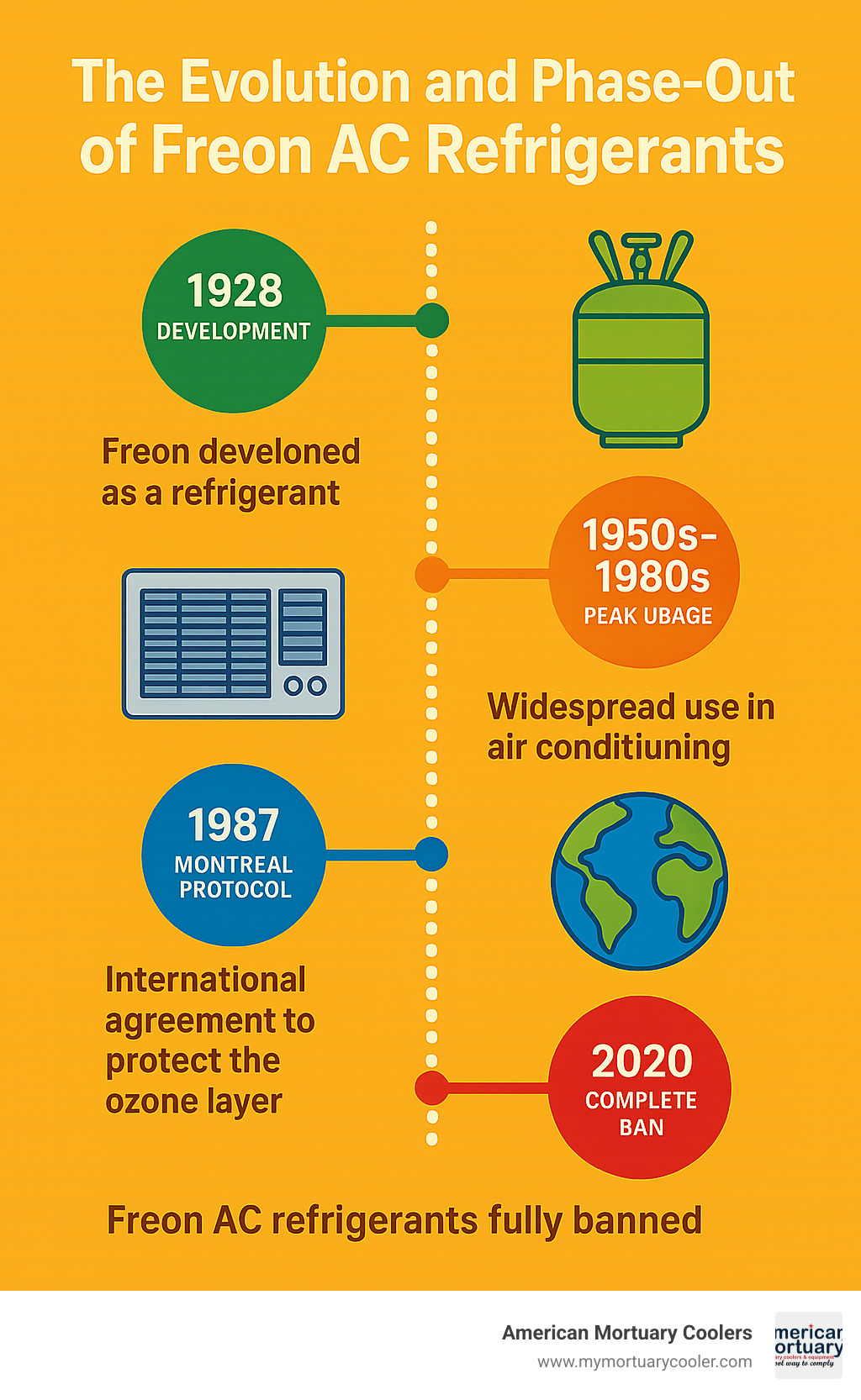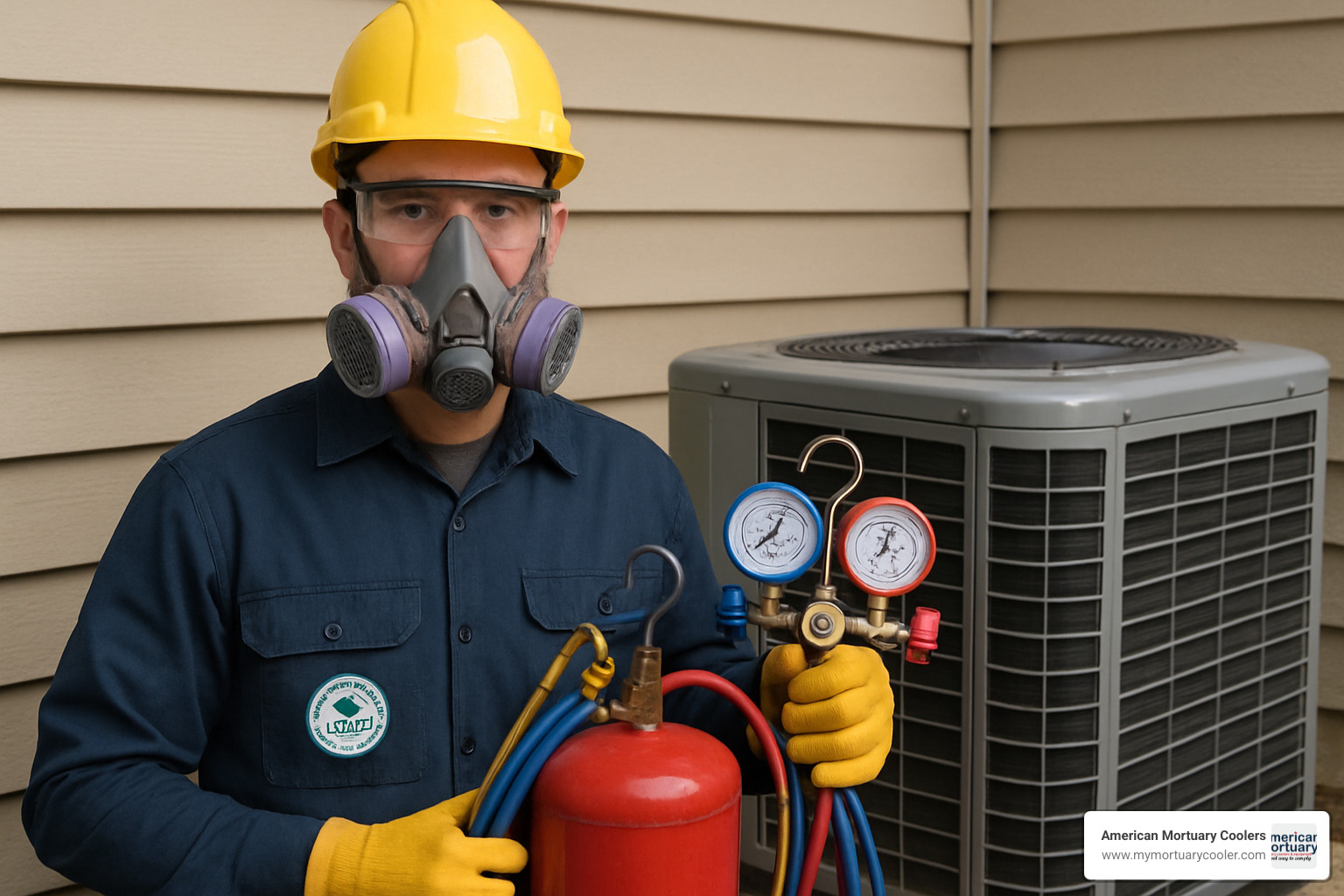
Freon AC 101: Everything You Need to Know About AC Refrigerants
Why Understanding Freon AC Systems Is Critical Today
Freon AC systems have been the backbone of cooling technology for decades, but major changes in regulations and technology are reshaping the entire industry. If you're dealing with an older air conditioning unit, you need to know what you're working with and what your options are.
Quick Answer for Freon AC:
- What it is: Freon is a brand name for R-22 refrigerant, a chemical that absorbs heat to cool air
- Current status: Banned for new production since January 1, 2020 due to ozone depletion
- Still legal: You can service existing R-22 systems with recycled refrigerant, but it's expensive
- Modern replacement: R-410A (Puron) is the standard in new AC units since 2010
- Cost impact: R-22 recharge can cost $100-$1000+ depending on availability
The story of Freon goes back to 1928 when Thomas Midgley Jr. developed it as a safer alternative to toxic refrigerants like ammonia and sulfur dioxide. By 1935, over 8 million American homes had air conditioners using this coolant. But what seemed like a perfect solution was quietly destroying the ozone layer.
The Montreal Protocol in 1987 started the global phase-out of ozone-depleting substances. The EPA banned R-22 production in 2010 for new equipment and completely stopped all production by 2020. This means if your AC unit was made before 2010, you're likely dealing with a Freon system that's becoming more expensive to maintain each year.
Whether you're a homeowner with an aging AC unit, a technician working on HVAC systems, or someone in the funeral industry managing specialized cooling equipment, understanding these changes affects your bottom line and compliance with environmental regulations.
As we've seen in our experience at American Mortuary Coolers with years of experience in refrigeration systems, the Freon AC phase-out has impacted cooling equipment across industries, from residential units to specialized mortuary applications.

Why This Guide Matters
This guide matters because the refrigerant landscape has fundamentally changed. Homeowners are facing expensive repair decisions, technicians need to understand new regulations, and everyone needs to comply with evolving environmental laws.
For homeowners, understanding whether your system uses Freon AC can mean the difference between a $200 repair and a $5,000 system replacement. For technicians, proper certification and knowledge of refrigerant handling is now more critical than ever.
How Freon Works in Air Conditioning Systems
Your air conditioner doesn't actually make cold air. Instead, it removes heat from your home and dumps it outside through a process called phase change - the same principle that makes you feel cold when water evaporates off your skin.

The refrigeration cycle involves four main components. The compressor squeezes refrigerant gas until it gets hot and pressurized. The condenser (outdoor coils) cools this hot gas until it turns back into liquid. The expansion valve suddenly drops the pressure, making the liquid much colder. Finally, the evaporator (indoor coils) lets this cold liquid boil back into gas, absorbing heat from your home.
What Is Freon and How Does It Cool Air?
Freon is actually a brand name owned by The Chemours Company, like "Kleenex" for tissues. The specific type that dominated home air conditioning was R-22, belonging to a chemical family called hydrochlorofluorocarbons (HCFCs).
Freon AC systems cool through vapor-compression refrigeration. When liquid refrigerant hits the evaporator coil, it boils in a low-pressure environment, absorbing huge amounts of heat through latent heat absorption. The refrigerant then carries this heat outside where it's released.
R-22 was ideal because it was non-flammable, chemically stable, and had excellent heat transfer properties. Many systems could run 20-30 years with minimal maintenance. Unfortunately, this "perfect" refrigerant had serious environmental consequences.
Freon vs. Refrigerant vs. Coolant
Freon is a specific brand name that people use generically, like "Band-Aid" for adhesive bandages. Refrigerant is the proper generic term for any substance used in refrigeration systems. Coolant is the broadest term for anything that removes heat from a system.
If your system was installed before 2010, it probably uses actual Freon AC refrigerant (R-22). Newer systems use different refrigerants, even though people might still call it "Freon."
For more details on refrigeration principles, check our refrigeration system basics guide.
The Evolution and Phase-Out of Freon AC Refrigerants
The story of Freon AC refrigerants is a classic tale of unintended consequences. Before 1928, early refrigerators used dangerous chemicals like ammonia and sulfur dioxide that could literally kill you if they leaked.
Thomas Midgley Jr.'s invention seemed like a miracle - Freon AC was non-toxic, non-flammable, and didn't corrode metal parts. By the 1960s, millions of homes used Freon-powered cooling systems as air conditioning became a standard middle-class amenity.
But in the 1970s, scientists finded that the ozone layer was developing holes, with the biggest over Antarctica. The culprit was those same "safe" refrigerants floating up to the stratosphere and destroying the ozone layer that protects us from harmful radiation.

Why Was Freon AC (R-22) Phased Out?
Ozone destruction was the primary concern. R-22 has an Ozone Depletion Potential of 0.055 - each molecule that escapes eventually reaches the stratosphere where chlorine atoms destroy thousands of ozone molecules.
Climate change was the second issue. R-22 has a Global Warming Potential of 1,810, making it nearly 2,000 times more powerful than carbon dioxide at trapping heat.
The EPA created a phase-out timeline: major restrictions began in 2004, no new R-22 equipment could be manufactured after 2010, and all production stopped on January 1, 2020. Details are available on the EPA phase-out details page.
How Does the Montreal Protocol Affect Homeowners and Car Owners?
Homeowners with older AC units feel the impact in their wallets. Since no new R-22 can be produced, recharges now use expensive recycled refrigerant, costing $500-$1,000+ versus the old $200 price.
You can still service existing R-22 systems legally, but every year makes repairs more expensive. The Montreal Protocol deliberately squeezed supply to encourage natural replacement over time.
Car owners went through this transition earlier, with the automotive industry moving away from R-12 Freon in the 1990s to R-134a and other alternatives.
Modern Refrigerants: What Your AC Uses Today
AC units manufactured after 2010 almost certainly use R-410A (Puron) instead of Freon AC. This transition brought significant improvements in efficiency and environmental impact.

R-410A offers zero ozone depletion potential and provides 10-15% higher cooling capacity than Freon AC systems. However, it operates at 50-70% higher pressure, so systems must be specifically designed for it - you can't simply swap refrigerants.
The Top Alternatives to Freon for Residential & Automotive Systems
R-410A (Puron) remains the current residential standard with zero ozone depletion. R-32 offers lower global warming potential but is mildly flammable. R-454B represents next-generation low-GWP refrigerants with improved environmental performance.
Automotive systems use R-134a (replaced R-12 in the 1990s) and newer R-1234yf with very low global warming potential. Some applications use R-744 (CO2) as a natural option.
For detailed specifications, see the Opteon™ refrigerants overview.
Can You Retrofit an Old Unit or Should You Replace It?
Drop-in replacement refrigerants like R-422B can work in R-22 systems with minimal changes, typically costing $800-1500. However, they rarely match original R-22 performance.
The age of your system is crucial. Units over 10-15 years old are often better candidates for complete replacement. If repair costs exceed 50% of replacement cost, upgrading usually makes more sense.
Cost-wise, R-22 recharges now run $500-1000+ and keep rising. New systems cost $3000-8000 but are 20-40% more efficient, offsetting much of the cost through energy savings.
Learn more about refrigerant options in our Dura Cool refrigerant guide.
How to Tell if Your System Still Uses Freon AC
Check the nameplate on your outdoor unit for refrigerant type. Look for "HCFC-22," "R-22," or "Freon" (older system) versus "R-410A" or "Puron" (modern system).
The manufacturing date is another indicator - units made before 2010 almost certainly use R-22, while post-2010 units use approved alternatives.
Service records should document refrigerant type used during repairs. When in doubt, have a certified technician identify your refrigerant during routine maintenance.
Maintenance, Safety & Legal Considerations
Working with Freon AC systems requires understanding strict EPA rules and safety risks. Only EPA-certified technicians can legally purchase and handle refrigerants - there's no homeowner exception.

Section 608 of the Clean Air Act makes venting refrigerant a federal crime with penalties up to $37,500 per day. Refrigerants can displace oxygen in enclosed spaces and cause frostbite on contact, making proper safety equipment essential.
Signs Your System Is Low on Refrigerant
Warm air from vents when the system should be cooling is the most obvious sign. You might also notice the system running constantly without reaching the set temperature.
Ice buildup on evaporator coils actually indicates insufficient heat absorption due to low refrigerant. Hissing sounds can indicate active leaks, and rising energy bills suggest the system is working harder.
If you notice these symptoms, turn off your system immediately and call a certified technician. Running low on refrigerant risks expensive compressor damage.
Is It Safe or Legal to Recharge Freon Yourself?
No, it's neither safe nor legal for unlicensed individuals to handle Freon AC refrigerants. EPA Section 608 certification is required to purchase refrigerants, with penalties reaching $37,500 per violation.
Safety concerns include frostbite risk, high-pressure dangers, and oxygen displacement. Proper charging requires specialized equipment and training that only certified technicians possess.
For safety information, check the EPA's refrigerant safety resources.
What to Do If Your AC Develops a Refrigerant Leak
Turn off your system immediately and ensure adequate ventilation. Don't attempt repairs yourself - document symptoms and call a certified technician.
Technicians will use electronic leak detectors to locate the source and properly recover all remaining refrigerant before repairs. The decision between repair and replacement often depends on system age and leak severity, especially with rising R-22 costs.
Frequently Asked Questions about Freon AC
How often does refrigerant need replacement?
Refrigerant should never need replacement in a properly working system. Your Freon AC unit is designed as a sealed system where refrigerant circulates endlessly without being consumed.
If a technician says you need refrigerant, you have a leak somewhere. Simply adding refrigerant without fixing the leak is temporary and environmentally harmful. Good technicians always locate and repair leaks before adding refrigerant.
What are the risks of handling Freon?
Freon AC refrigerants pose several dangers. Frostbite from direct contact with liquid refrigerant at minus 40°F can cause permanent damage. Asphyxiation risk exists in enclosed spaces where heavier-than-air refrigerants displace oxygen.
Some refrigerants cause cardiac sensitization, affecting heart rhythm. Environmental risks include contributing to ozone depletion and climate change. High-pressure systems can cause serious injury if components fail.
This is why EPA certification is required - professionals have the training, equipment, and insurance to handle these materials safely.
Are newer refrigerants truly greener?
Yes, modern refrigerants are dramatically better for the environment than Freon AC systems. The biggest improvement is zero ozone depletion - R-410A doesn't harm the ozone layer at all.
Many newer refrigerants provide better heat transfer efficiency, reducing energy consumption. The industry is moving toward even greener options like R-32 (two-thirds the global warming potential of R-410A) and R-454B (80% lower global warming potential).
Natural refrigerants like CO2, ammonia, and propane have minimal environmental impact but come with safety challenges. The trend is definitely toward greener options, balancing environmental responsibility with safety and performance.
Conclusion
The world of Freon AC systems has changed dramatically, and understanding these changes can save you thousands while keeping you compliant with environmental regulations.
If you have an older R-22 system, the math is straightforward. When a single Freon AC recharge costs $500-$1,000+, and you might need multiple recharges, replacement often makes more sense. Modern R-410A systems use 20-40% less energy, run quieter, and break down less often.
Safety and legal aspects matter too. Only EPA-certified technicians can legally handle refrigerants. Attempting DIY repairs risks hefty fines and dangerous situations.
At American Mortuary Coolers, we've helped funeral homes across Tennessee and throughout the contiguous 48 states upgrade their cooling systems. The reliability improvements alone justify the investment - equipment failure simply isn't an option when serving families.
Environmental benefits are real. Every old Freon AC system replaced helps protect the ozone layer and reduces greenhouse gases. It's one of those rare situations where environmental responsibility makes financial sense.
The key is planning ahead rather than waiting for emergency repairs. When summer heat hits and your old system fails, you'll face limited options and premium emergency pricing.
By staying informed and making proactive decisions, you can enjoy better comfort while supporting a healthier planet. For more information about our refrigeration solutions, visit our main website.



